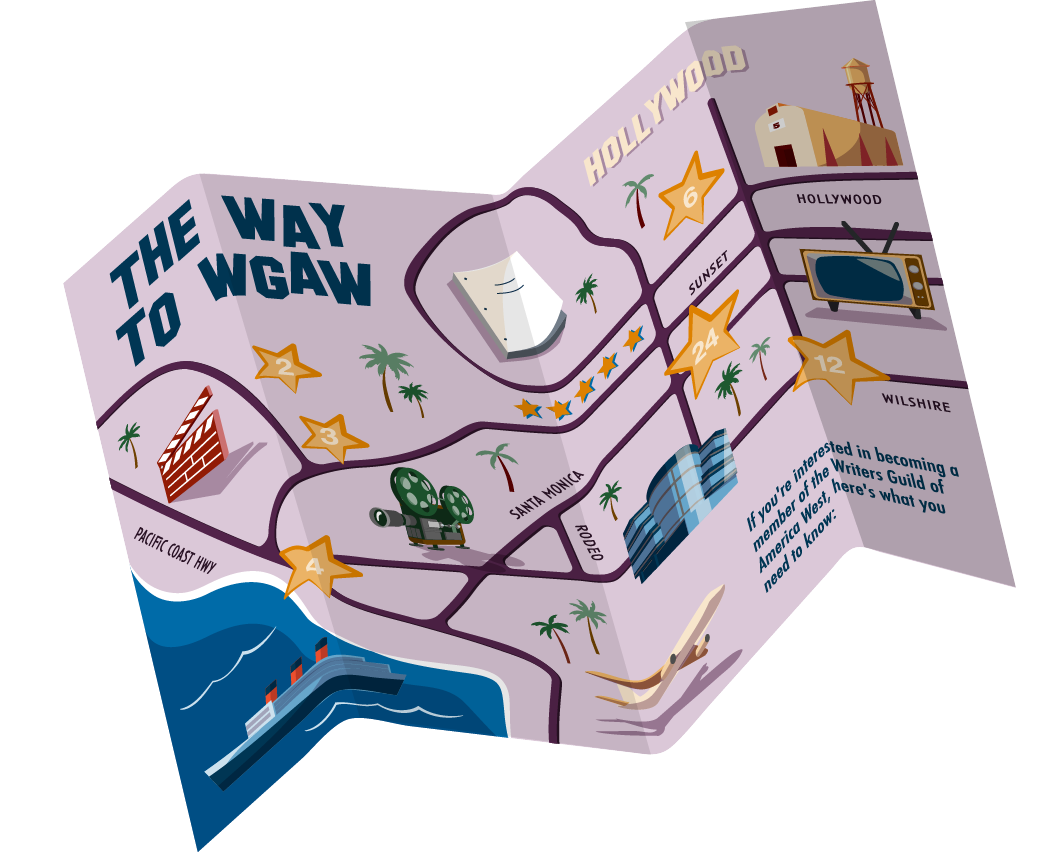Members
Updated October 7, 2021
Screen deals typically include both initial compensation and various types of bonuses. By reviewing screenwriter contracts, including those provided by agencies through our franchise agreement, the Guild has compiled this Screen Bonus Guide to outline key types of screen bonuses, the best terms and sample deal language. Writers and their representatives can consult this information as they negotiate overscale pay. This Guide supplements prior Deal Hub guides to going rates for screen compensation as well as screen deals specifically for streamers and our Screen Deal Tips.
Bonus Overview
There are numerous types of bonuses in screenwriter contracts, in addition to a typical percentage of net proceeds which is often referred to as “points.” While “Hollywood accounting” has often meant that a negotiated share of net proceeds may never result in actual compensation to the writer, contingent bonuses can mean real money for writers if a screenplay is produced and released. This is more important than ever given the rise of streaming distribution that increasingly eliminates the residuals received from a traditional progression through multiple reuse markets for home video, licensing to premium TV networks, and beyond.
Writer contracts may include several types of bonuses, each tied to a specific event in the project’s life cycle:
- When the project is set up at a studio
- When the project goes into production
- When a writer receives writing credit on the project
- When a writer is the last writer hired
- When box office reaches certain thresholds
- When the project debuts on streaming
- When the film is nominated for or wins a major award
In general, while contingent bonuses can be great extras to your deal, writers and their representatives should always seek to negotiate that compensation be paid as early as possible, and if possible guaranteed. Companies may also offer a bonus payment that can be reduced by any initial compensation paid to you before the bonus, but it’s always better to negotiate a bonus that is not reduced by other compensation instead.
Keep in mind that once the goalpost for the bonus has been met, the bonus is due and payable within seven days. Contact the Guild if your bonus is late and we will help you collect your bonus, MBA interest and P&H contributions on the payment (if you haven’t reached the cap).
This Guide outlines key bonus terms through the various stages of a screen deal.
Set-Up Bonus
In the life of your deal, an early opportunity for a bonus is when the project is “set up” for further development or production, with various payouts at different types of studios. Set-up bonuses allow you to participate in the gains if your screenplay goes to an outlet that makes high-budget films. In our review of high-end deals, these bonuses can range from $100,000 to $500,000 for Netflix or Amazon, a major studio, or a major-owned streaming service like Disney+, and $50,000 to $250,000 for Hulu, a mini-major, major independent studio or other production or distribution entity.
Sample: If the Picture is set up for further development and/or production with any so-called major, mini-major or major independent U.S. or European motion picture company (“Studio”), then Artist shall be entitled to receive a one-time set-up bonus in an amount equal to $xxx payable upon Company entering a binding agreement with Studio.
Production Bonus
Production bonuses ensure that you are paid additional compensation if your screenplay gets produced, typically paying out upon commencement of principal photography. These bonuses, which can also be a percentage of the film’s budget, may range from $100,000 to $1.25 million at the high end. As with credit bonuses, any payment calculated as a percentage of a film’s budget should include a floor to ensure that you are paid appropriately even if the film’s budget is lower than anticipated. For instance, a production bonus could be equal to 3.25% of the budget of the film, with a floor of $400,000 less previous sums paid to the writer.
Sample: If the Picture is produced using Artist’s material written hereunder in whole or in part, Artist shall be entitled to a production bonus of $xxx payable not later than seven (7) days following commencement of principal photography of the Picture (“Production Bonus”).
Credit Bonus
Credit bonuses are one of the most common types of bonus, paid if you receive sole or shared credit on the produced film. They also offer some of the highest value of the bonuses reviewed here. Credit bonuses may be calculated as a specific fee or as a percentage of the film’s budget. At the high end, these bonuses can reach $500,000 to several million dollars or 3% to 10% of the film’s budget for sole credit.
Shared credit bonuses may be up to 50% of the bonus a writer would receive for sole credit. In addition, some sole credit bonuses apply even if you are sharing credit with a writer who was previously employed on the project, while the “shared” credit bonus applies only if the credit is shared with a writer brought onto the project after you.
- If the bonus is calculated as a percentage of the film’s budget, make sure to negotiate a floor; top credit bonuses have included a floor (or a “greater of” provision) as high as $1 million to $3 million less amounts previously paid to the writer. If you are able to avoid a negotiated ceiling, you would share in the entirety of a higher budget.
- Companies often try to deduct any compensation received in writing steps from the total bonus amount. Be aware of this when negotiating for the total bonus amount.
As noted in the Screen Deal Tips, you should negotiate that any credit bonuses are triggered by both “screenplay by” and “teleplay by” credit in the event that the theatrical project is later produced as a television or new media project.
Sample (flat payment):
- If Artist receives sole “written by,” sole “screenplay by,” or sole “teleplay by” credit, Artist shall receive a bonus equal to $xxx flat, payable within seven (7) days following Company’s receipt of the Final Credit Determination
- If Artist receives shared “written by,” shared “screenplay by,” or shared “teleplay by” credit, Artist shall receive a bonus equal to $xxx flat, payable within seven (7) days following Company’s receipt of the Final Credit Determination.
Sample (percent of budget, deducting amounts paid prior):
- Sole Credit: The greater of (a) 10% of the ingoing budget for the Picture less all payments previously made to Artist for the guaranteed steps; or (b) $xxx less all payments previously made to Artist for the guaranteed steps, payable within seven (7) days of Final Credit Determination.
- Shared Credit: 50% of the amount due pursuant to subparagraph above, payable within seven (7) days of Final Credit Determination.
Last Writer Bonus
A screen project may pass through the hands of several writers along its path to production. You can negotiate a provision in your deal such that if the project is produced and you are the last writer engaged but you do not receive credit, you get a payment that takes the place of a credit bonus. These “last writer” bonuses may reach over $300,000, and may be paid on commencement of principal photography or final WGA credit determination.
Sample: “In the event Artist is the last party engaged to render writing services on the Picture (excluding a director’s pass, so‐called roundtable, dialogue polish and/or any other revision by a non‐writing “production executive”) (“Last Writer”) but is not accorded Sole Credit or Shared Credit hereunder, Artist shall be entitled to a “Last Writer Bonus” in connection with the Picture of $xxx payable upon Company’s receipt of Final Credit Determination.
Box Office Bonus
These bonuses pay out set amounts if the film is released theatrically and achieves specified domestic or worldwide box office receipts. Box office targets may be defined, or they may be multiples of the film’s production cost or the production and distribution costs. The value of a box office bonus depends on the initial threshold for payment and subsequent increments, and may also be reduced by 50% in the case of shared credit.
- The initial threshold for the first bonus payment may begin at 2 times the film’s negative cost or $50 to $100 million in Domestic Box Office
- Subsequent thresholds may be increments of $5 to $25 million in Domestic Box Office or 0.25 times the film’s negative cost
- Specific bonus payments may be $100,000 to $500,000 for each box office target reached
Box office bonuses may pay out millions of dollars for the highest-performing features. However, many screen projects now end up on streaming services, either in addition to or in lieu of a traditional theatrical release. Try to negotiate a bonus that is paid if the project has its initial release on a streaming platform—see the next section for more details.
Sample:
Box office bonuses as follows:
- $xxx payable at the point, if ever, at which the worldwide theatrical box office receipts ("WWBO") of the Picture equal or exceed Three (3) times the "Cost of Production" (as defined below) of the Picture (the "Initial Point");
- $xxx payable at the point (as applicable, the "Second Point"), if ever, at which the WWBO equals or exceeds the greater of (i) the Initial Point plus Twenty-Five Million Dollars ($25,000,000) of WWBO, or (i) Three and One-Quarter (3.25) times the Cost of Production of the Picture;
- $xxx payable at the point (as applicable, the “Third Point"), if ever, at which the WWBO equals or exceeds the greater of (i) the Initial Point plus Fifty Million Dollars ($50,000,000) in WWBO, or (ii) Three and One-Half (3.5) times the Cost of Production of the Picture;
- $xxx payable at the point (as applicable, the "Fourth Point"), if ever, at which the WWBO equals or exceeds the greater of (i) the Initial Point plus Seventy-Five Million Dollars ($75,000,000) in WWBO, or (ii) Three and Three-Quarters (3.75) times the Cost of Production of the Picture;
Streaming Bonus
Increasingly, writers have begun to negotiate bonuses to be paid if their theatrical project is released primarily on a streaming service. The terms of these newer bonuses are still developing, but streaming bonuses (sometimes also called a streaming advance, or a streaming buyout) may pay $100,000 up to $1 million. These bonuses, which may be instead of or applicable against backend compensation, are often paid only if the writer receives sole or shared credit; an alternative is to negotiate an increase in your credit bonus if the project is released to streaming.
Sample: “Should the Project be distributed by a streaming service and there is no wide domestic theatrical release, Artist is entitled to a one-time $xxx bonus (the “Streaming Bonus”). For avoidance of doubt, a limited theatrical release by the streaming service (e.g. for purposes of qualifying for an Academy Award) shall not preclude payment of the Streaming Bonus, provided the Box Office Receipts are not sufficient to trigger any Box Office Bonuses.”
Award Bonus
Some screen deals specify a bonus to be paid if your screenplay is nominated for or wins an award. These bonuses do not vary substantially in value and typically pay out if the project is nominated for or wins an Academy Award or a Golden Globe, though other awards occasionally qualify, including the Writers Guild Awards. These bonuses may pay up to, for instance:
- $50,000 to $100,000 for an Academy Award nomination or $100,000 to $150,000 for a win
- $25,000 to $50,000 for a Golden Globe nomination or $50,000 to $100,000 for a win
Sample: If Artist is nominated for or wins the Academy Award or Golden Globe in the category of “Best Original Screenplay”, Artist will be entitled to the following bonuses (“Awards Bonus(es)”): (i) if Artist is nominated for the Academy Award or Golden Globe, $xxx; (ii) if Artist wins the Academy Award, an additional $xxx; or (ii) if Artist wins the Golden Globe, an additional $xxx. The Awards Bonus(es) shall be payable within seven (7) days following the date of the applicable nomination announcement or award broadcast, and shall not be applicable against any compensation paid or payable to Artist hereunder.
Contract language is provided here for illustration purposes only. Consult with a representative or the WGAW when negotiating your own deal.





